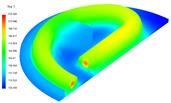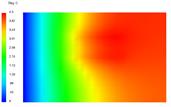■
Thermal conductivity, density and specific heat is defined in the property table
■
Thermal conductivity, density and specific heat can be temperature, temperature difference, time and time cyclic dependent
■
Anisotropic thermal conductivity, (different in the X,Y and Z directions based on user defined coordinate system)
■
Elements can be four or three sided
■
Thermal conductivity, thickness, density and specific heat is defined in the property table
■
Anisotropic thermal conductivity, (different in X and Y directions based on user defined coordinate system)
■
Thermal conductivity, density and specific heat can be temperature, temperature difference, time and time cyclic dependent
■
Plate elements can be extruded into three dimensional brick elements
■
Plate elements can be generated from the face of brick elements
■
Plate elements can be generated by either selecting the four (or three) corner nodes or by selecting the two diagonal nodes
■
Plate elements can be generated from the face of brick elements
■
Primitive shapes can be generated automatically.
■
Elements can be six or five sided
■
Thermal conductivity, density and specific heat is defined in the property table
■
Thermal conductivity, density and specific heat can be temperature, temperature difference, time and time cyclic dependent
■
Brick elements can be generated by either selecting the eight (or six) corner nodes or by selecting the two diagonal nodes
■
Anisotropic thermal conductivity, (different in the X,Y and Z directions based on user defined coordinate system)
•
IntelliMesh thermally attaches parts of the model that are meshed differently
•
Variables can be defined that can be referenced by any item in the property table.
•
Three types of radiation elements can be generated, node-to-node, node-to-surface and surface-to-surface. The elements can reference the property table where emissivity and view factor are defined. Emissivity and view factor can be time or temperature dependent The TRASYS thermal radiation software is included with Solaria used to generate Surface-to-Surface radiation elements accounting for view factors, shadowing and different emissivities.
•
Convection elements can be generated from a plate element, the face of a brick or tetrahedron to a single node. The heat transfer coefficient is defined in the property table and can be temperature, temperature difference, time or time cyclic dependent.
•
Scalar resistor elements can be generated between any two nodes. They can reference a property and be a function of geometry and can add capacitance to the model
•
Fluid flow elements can be generated to account for the fluid temperature rise and fall.
•
Nodal, surface and volumetric heat loads can be fixed or temperature, temperature difference, time or time cyclic dependent
•
On/Off and proportional thermostat can control heat loads. On/Off thermostat has hysteresis.
•
Boundary or fixed temperature nodes can be defined. They can be time or time cyclic dependent.
•
Documentation on the model can be saved with the model.
•
Coordinate systems can be user defined and used to define thermal conductivity orientation.
•
Any consistent units can be used, Degrees C, F or absolute can be used.
•
Materials can be selected from a material library.
•
Models can be solved interactively.
•
Model is shown three dimensionally on the screen using colors to represent element type, properties and temperatures.
•
Screen view can be windowed, panned or zoomed manually or dynamically.
•
Groups of elements can be defined.
•
Three dimensional color contour plots can be view on the screen.
•
Hidden line and property plots can be viewed on the screen.
•
Model outline can be viewed.
•
Transient results can be plotted using a built in routine and animated (AVI files can be saved, put them right into your PowerPoint presentation).
•
TRASYS radiation models can be created. TRASYS results can be loaded back into Solaria to automatically generate surface-to-surface radiation elements. Both steady state and transient cases are supported.
•
Element information can be queried and displayed.
•
Transient plot data can be saved to disk separately.
•
Both SINDA/G and SINDA/FLUINT models can be created by Solaria. FORTRAN generated in the OUTPUT block creates both steady state and transient Solaria compatible results files allowing Solaria to used as a Pre and Post processor for SINDA.
•
Solaria contains a complete interface with FEMAP
•
MSC/NASTRAN and ANSYS files can be imported










